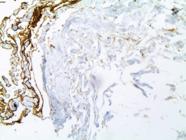ABSTRACT
Purpose:
To identify the lymphatic vessels in orbital specimens from human cadavers using light microscopy and immunohistochemical analysis.
Methods:
A postmortem study included 10 orbital specimens from 10 human cadavers. The orbital specimens were obtained no later than 12 hours after death. The orbital specimens were dissected into lacrimal gland, optic nerve, fat tissue, and oculomotor muscles. The histologic criteria to qualify as a lymphatic vessel were thin-walled channels of endothelium without a well-developed basal membrane and with an erythrocyte-free, irregular lumen. The immunohistochemical criteria were irregularly shaped, thin-walled vessels with an erythrocyte-free, irregular lumen and immunopositivity for podoplanin D2-40.
Results:
The lacrimal gland, optic nerve, fat tissue, and extraocular muscle sections were positively stained with podoplanin D2-40.
Conclusions:
This study demonstrated lymphatic vessels in the human orbit, more precisely, in the lacrimal gland, dura mater of the optic nerve, adipose tissue, and extrinsic oculomotor muscles via light microscopy and immunohistochemistry.
Keywords:
Lymphatic vessels; Orbit; Optic nerve; Lacrimal apparatus; Oculomotor muscles; Adipose tissue; Microscopy

 Thumbnail
Thumbnail
 Thumbnail
Thumbnail
 Thumbnail
Thumbnail
 Thumbnail
Thumbnail



